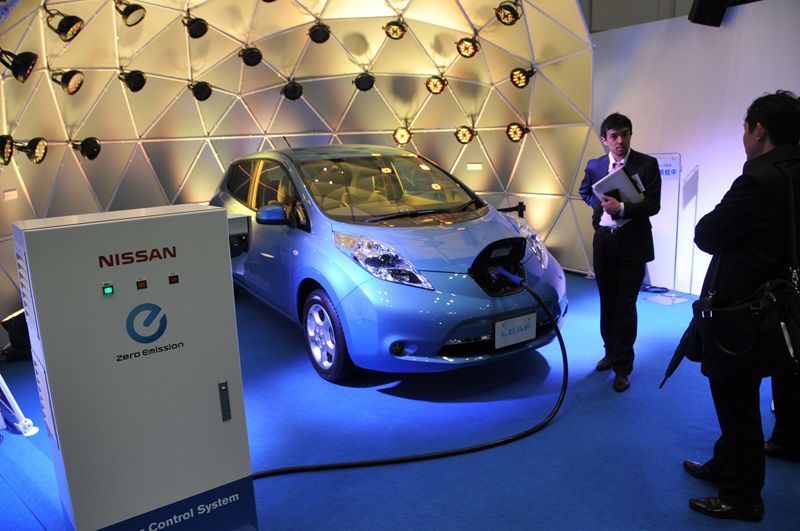
What Does the Future Hold for Japanese Automakers?
Economy- English
- 日本語
- 简体字
- 繁體字
- Français
- Español
- العربية
- Русский
The malaise affecting the Japanese manufacturing sector is often attributed to “six hardships,” among them the galloping yen and heavy corporate taxes. All of Japan’s major electronics manufacturers, including Panasonic, Sony, and Sharp, are set to post losses for the current fiscal year. But what about the automobile industry—the mainstay of the Japanese economy? At first glance, the situation looks brighter. Even Honda, which suffered a double whammy in 2011 from the Tōhoku earthquake and extreme flooding in Thailand, expects to register a ¥215 billion profit for the fiscal year ending March 31, 2012. (Even so, this marks a 60% decrease from the previous fiscal year).
The Japanese automobile industry has thus shown its distinctive brand of resilience. Even so, some people are asking whether the industry’s recipe for success will continue to be effective as electric vehicles and other new forms of mobility emerge. My view is that although new market players will make competition more intense, the automotive industry is unlikely to collapse in the same way as the Japanese electronics industry.
Twin Pillars
Automobile and electronics exports are the twin pillars that have sustained Japanese economic growth since the 1970s. Both are assembly industries, and on the surface both may seem to be plagued by the same six hardships. But in fact there are significant differences between them.
Fujimoto Takahiro, a professor at the University of Tokyo who studies the tradition of craftsmanship (monozukuri) in Japanese industry, draws a distinction between two major approaches to manufacturing. First is the “modular” approach, typified in recent years by the electronics industry. In this approach, personal computers and flat-screen televisions are produced by assembling key components like display screens and CPUs. The second “integral” approach, best represented these days by the automobile industry, involves assembling tens of thousands parts in an optimal way to ensure a smooth and comfortable ride.
With the modular approach, a corporation needs to come up with the concept for an original new product, including its design, and gather together the key components from around the world. It then has to assemble the product in low-cost regions and export the finished product. Japan has failed to adapt successfully to this kind of multi-stage process, and this weakness has led to the collapse of its electronics industry. Its automobile companies are much more resilient. This may be because their emphasis on teamwork makes them well-suited to the integral approach, in which development and production sites work in tandem to hone product development, and production plants make continual improvements to quality.
Strengths to Draw On
 Many environmentally friendly vehicles, like this EV, were on view at the 42nd Tokyo Motor Show.
Many environmentally friendly vehicles, like this EV, were on view at the 42nd Tokyo Motor Show.
Even so, some people doubt whether this model will continue to bring success. According to this view, as EVs become more common, automobiles will be transformed into a sort of “household appliance,” with batteries and motors as their key components. Another worry is the increasing number of companies attracted by the potential of the growing EV market. These include US-based Tesla Motors and new startups in China.
It is true that the Japanese automobile industry will now face more competition, and not just from existing rivals—there will be new alliances between automakers, electronics firms, and venture businesses to deal with too. New players are already making the market increasingly competitive. But manufacturing automobiles is not like making PCs. It is not just a simple matter of assembling components. A car’s drivability will always depend on elements unique to the particular company that made it. Safety is another crucial area where long years of experience give existing automakers an advantage over newcomers.
Newcomers may find it hard to create a car capable of cruising at high speeds on the expressway, but there is more room for them to compete when it comes to production of “personal commuter” vehicles intended for city driving. Competition in the new EV era is much tougher than it was when the conventional automakers had the market to themselves. If the automakers become complacent, there is a risk that they could be swept aside.
But so far, Japanese automakers have shown enough resilience to cope with the six hardships. This should be enough to ensure that they avoid the fate that has befallen Japan’s electronics firms—although this optimistic prognosis may be swayed by the perhaps excessive faith I have in the prowess of Japan’s car professionals. (February 15, 2012)
(Originally written in Japanese.)Yasui Takayuki Asahi Shimbun Nissan automobile industry Honda Toyota venture business electronic vehicles EVs Fujimoto Takahiro module model integral model assembly